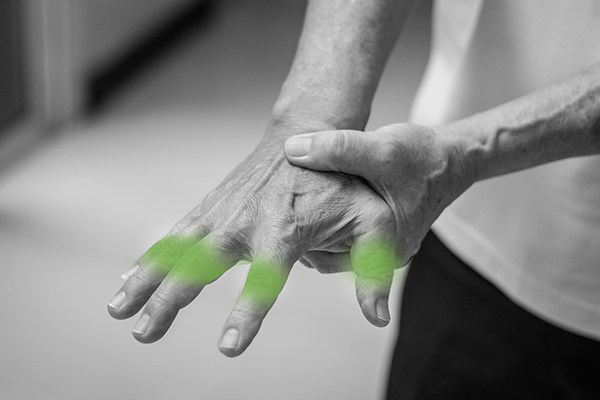I’m an associated practitioner with Arthritis Action, one of only two in the North East. Arthritis might not seem like a great subject for ‘chat’, but I find that there’s loads of things to talk about. It’s one of the subjects that comes up most often in my clinic and it’s something that interests all ages. Today I’m going to ask –
Arthritis – what actually is it?
Hands up if you immediately thought – ‘wear and tear; happens to you when you get old; need to lose weight.’
For sure, all those things are part of the story. But take a look at the hand you just raised. Our fingers don’t undergo that much wear and tear do they? And how much difference would weight loss make to our hands? Yet hands and fingers are one of the common places to develop arthritis. So, what’s going on?
The first thing to say is that this ‘chat’ is actually a very long conversation and there are loads of things to talk about. But for today I’m going to stick to Osteoarthritis (Rheumatoid is for another time) and explain what it is, and what it isn’t.
Let’s call osteoarthritis OA for short. OA is the most common type of arthritis and it can cause our joints to feel stiff and painful. It’s definitely more common in older people but it can also affect younger people as well, especially if you’ve had an injury or surgical repair to a joint. Sometimes OA causes the joints to swell and change shape, especially the finger joints, and sometimes OA joints make creaking or cracking noises.
The symptoms of osteoarthritis can vary a lot. It’s the most remarkable thing that sometimes in my clinic I can examine someone’s joint and it clearly has the stiffness of OA and yet the person feels no pain at all. At other times pain can be severe but moving the joint is easy. People also experience a loss of muscle around OA joints and this can make them feel weaker. Almost all joints can develop OA but the most common places are the fingers, thumbs, knees and hips as well as the low back and neck.
Fingers and thumbs? Wait a minute, we’re back to that question about wear and tear again. Why fingers and thumbs as well as the weight bearing joints?
Osteoarthritis used to be called ‘wear and tear’ arthritis because it was thought that the joints gradually wore out with use and that this was inevitable as we get older. We now know much more about this than we used to. In fact, the process of OA is much more complicated than that.
Inside the affected joints there is quite a lot of inflammatory healing and repair going on. Part of this healing and repair process leads to a loss of cartilage. Cartilage is the smooth tissue inside the joint which surrounds and protects the ends of the bones and acts as a shock absorber. As the cartilage is lost, new bone forms in a higgledy-piggledy way and this can cause the joints to look lumpy or become bent. This inflammatory process of breaking down cartilage and building new lumpy bone is what leads to pain and stiffness in OA joints.
No-one knows exactly what causes the inflammation of osteoarthritis but it may be due to repeated small injuries that happen as part of daily life which don’t heal completely. We do know that injuries such as a broken bone or sporting injury can lead to OA later in life. OA can also run in the family with some people being more at risk of developing it. Then there’s the question of being overweight. That inflammatory process can occur in fingers and thumbs whatever weight we are, but being heavier does put extra strain on the weight-bearing joints, especially the knees and hips and this can lead to more severe OA.
That’s what Osteoarthritis is. Let’s talk now about what it isn’t.
- It isn’t inevitable, although the risk of developing OA does increase as we get older
- It isn’t something that just gets worse for ever, the pain and stiffness can come and go.
- It isn’t something we ‘just have to put up with’. There are lots of things we can do to help manage the pain and stiffness.
Those last three points make me feel much more hopeful about OA compared to the idea of – ‘wear and tear; happens to you when you get older; need to lose weight;’ as we mentioned at the beginning. I find that outcomes for me and my clients are so much better when we have more understanding of a condition or problem and more ideas about what we can do to help ourselves and each other.
So, with that in mind, keep a look-out for my blog-posts. I’ll be back soon with more ‘Arthritis Chat’ to talk about different types of arthritis; different exercises; diet; arthritis in younger people; joint replacement surgery; osteopathic treatment; new research and more.

